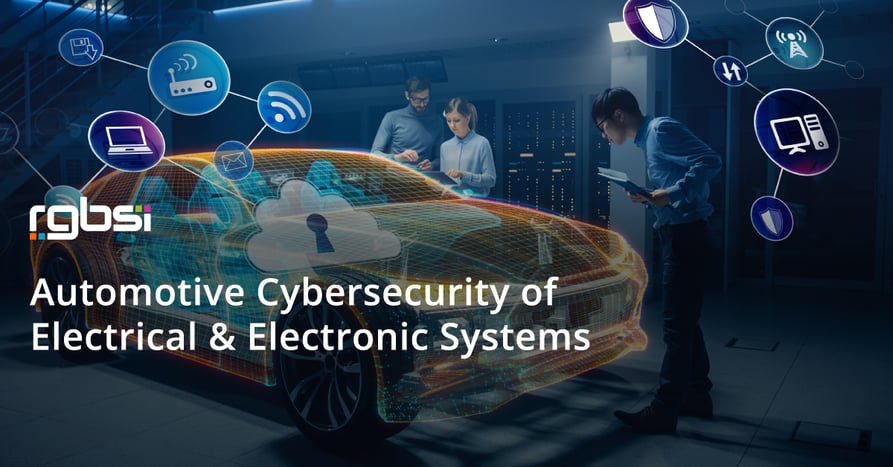
The most recent developments in driver assistance technology depend on various electronic components, detectors, and digital communications. The technology behind driverless cars, also known as autonomous vehicles or AVs, is advancing at a breakneck pace. Consequently, there has also been an increase in the number of cyberattacks.
Throughout the last few years, the cybersecurity risk posed by integrated automobiles has become increasingly apparent as information security experts have uncovered various technological flaws. Threat situations likely to result in high-severity repercussions warrant additional attention and, perhaps, demand the development and execution of preventive measures across electrical & electronic systems.
What is Automotive Cybersecurity & Why is it Important?
Cybersecurity concerns everyone. Communication and technology powered by complicated programming are essential to many aspects of modern life, including business, personal life, and even transportation. The more information technology plays a role in people's daily lives, the more dependent they will become on following computer systems. As a result, people face an increased risk of being vulnerable to attacks and having possible attacks launched onto their systems.
When applied to automobiles, cybersecurity tends to take a far more crucial function: the electrical systems and electronic elements that regulate protection need to be safeguarded from malicious attacks, illegal access, destruction, or any other circumstance that can compromise the essential functions.
Many people are now investigating the broad range of its capabilities and resources to ensure that these innovations are implemented securely, speedily, and successfully. This investigation requires taking measures to deal with these innovations' barriers, including cybersecurity concerns.
Automotive Cybersecurity Protection Methods
A faceted cybersecurity strategy focuses on a vehicle's wired and wireless entryways that could be exposed to a cyberattack. One example of this technique is the Tesla Autopilot system. A multi-layered response to automotive cybersecurity minimizes the chance of a successful attack on an automobile and lessens the possible repercussions from an intrusion.
Here are 5 automotive cybersecurity protection methods:
1. Vehicle Risk Management
The participants in the automotive industry must:
- Ensure end-to-end threat management.
- Select appropriate cybersecurity threats in their kinds of vehicles as well as in neighboring system electronics that may influence vehicle security or safety.
- Guarantee that they enforce mitigation measures to reduce such hazards. This enforcement involves paying attention to threats that are constantly developing.
2. Security of Architecture in Development (Hardware, Software, Network, Cloud)
Original equipment manufacturers or OEMs are responsible for creating reliable vehicles right from the early stages. You can accomplish this by implementing cutting-edge software and hardware development engineering techniques. You can also help this process by ensuring all vehicle types are crafted, constructed, and evaluated for system vulnerabilities and that every computer security risk is appropriately minimized or eliminated.
Although OEMs are wholly accountable for cybersecurity, all production chain actors must provide their contributions.
3. Detection & Response to Security Threats
Motor vehicle designers must be able to identify any technical flaws or security problems in their products, as well as in any nearby system elements, which may influence the safety or integrity of their motor vehicles.
4. Vulnerability Analysis & Testing
The stakeholders in the auto industry ought to be capable of responding to any identified breach of security and releasing software upgrades to address any vulnerabilities.
5. Track Software in Vehicles & Provide Safe and Secure Updates
Automotive manufacturers are responsible for monitoring vehicles that need system upgrades and ensuring that these new features will not compromise licensed security features and are consistent with the design of the automobiles.
Regulations/Certifications/Auditing
Threat possibilities that can have serious repercussions merit additional consideration and may call for developing and executing risk management measures.
ISO 21434 Standard - Cybersecurity Assurance Levels and Risk Value
ISO/SAE 21434 requires a risk value for each danger scenario. Risk relies on the attack's potential and severity. You will reduce the danger if the attempt involves a group of experienced hackers and expensive equipment. Worst-case circumstance, the attack is simple but has devastating effects.
Cybersecurity Assurance Level or CAL is a network, element, or cybersecurity objective feature. CAL is dependent on the attack's intensity. Depending on the target CAL, some cybersecurity measures can be skipped or done less thoroughly. CALs help to adapt cybersecurity actions to the intended security level and ease investor and production chain interactions.
Automotive cybersecurity should be taken seriously as the world becomes increasingly digital. It is crucial to emphasize the influence of present safety solutions and those planned for future cars and their electrical & electronic systems with increased automation and interconnectivity.
About RGBSI
At RGBSI, we deliver total workforce management, engineering, quality lifecycle management, and IT solutions that provide strategic partnership for organizations of all sizes.
Electrical & Electronic Services
We offer state-of-the-art services that fully integrate electrical and electronic design through manufacturing. With a “think forward” outlook, clients’ use our team of experts to ensure their products, systems, and processes are always current and compliant in the most efficient way possible.
Automotive Cybersecurity Services
- Support development of security architecture
- Threat scenario and damage scenario
- Cybersecurity assurance level and risk value
- Attack path analysis
- Vulnerability analysis and testing
- Cybersecurity analysis on ISO 21434
Learn more about electrical & electronic services.











